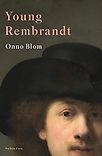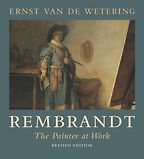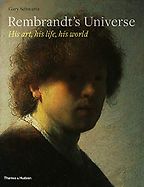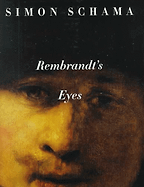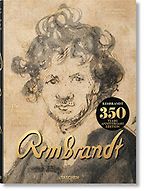Let’s start in the town of Leiden, in Holland. Like Rembrandt, you are a Leiden native. What motivated you to write your book about the young Rembrandt?
As a child I was really fascinated by literature and history. Books really fired my imagination, and at the same time I really loved going to the museums in Leiden. We have some very beautiful museums featuring ancient history—the Egyptians, for example—and other fascinating chapters of history. Of course, for someone from Leiden, Rembrandt is the most famous historical figure. He’s alive in the heads of all people from Leiden, even if he also remains something of a mystery. As a young boy, my father took me to the Museum de Lakenhal, the museum of paintings, and showed me the one painting that was then in the Leiden Lakenhal called the Leiden history painting by Rembrandt. I was fascinated by that painting.
My father, a historian, pointed out to me that Rembrandt plays a cameo role in that painting. His name was already familiar to me—in Leiden, his name is everywhere. Schools are named after Rembrandt, stairs, streets. Already as a child, although his name was familiar, he was an enigma. In some ways I think he will always remain an enigma. There, for the first time, standing hand in hand with my father before this painting, I was fascinated to find myself looking Rembrandt himself in the eye, and he looked back at me. For the first time, I saw who he was, a physical representation.
Immediately, it struck me the way Rembrandt had painted himself because he has these incredible curls—lots of really curly hair, which he rendered not in paint but with the wooden tip of his brush into the wet canvas. It’s so skilfully done that even today it looks like a little miracle to my eyes. Very Rembrandt. From that very first time, from the age of seven or so, I became fascinated by him.
“When I wasn’t writing, I was walking the streets of Leiden in search of Rembrandt’s ghost”
That fascination stayed with me. Growing up in Leiden, I went to what they call here the gymnasium, the Latin School. As it happens, Rembrandt attended it too, centuries ago. Like Rembrandt, my studies took me from Leiden to Amsterdam as well. There I studied with professor Ernst Van Der Wetering, one of the most prominent Rembrandt scholars. And so, this artist has always stayed in my mind.
Twelve years ago, I started writing a biography on a Dutch painter, sculptor and writer called Jan Wolkers, who is very famous in Holland. There’s a novel of his, Turkish Delight, translated into many languages, and he ended up being the subject of my PhD thesis. Jan Wolkers, who was born in 1925 in a little village near Leiden, was similarly fascinated by Rembrandt. For him as a boy with a Calvinistic religious background, Rembrandt made the Bible come alive. Wolkers made his first self-portraits in Leiden, in the midst of the Second World War, right next to reproductions of Rembrandt’s etchings. After I finished the book on Wolkers, I was invited to write about the connection between the two artists. Much of this connection already featured in my thesis.
And then I thought: this is the right time to start writing my own story, about my fascination with Rembrandt, growing up in my own home city. This was two years ago. Since then, I’ve been thinking about Rembrandt almost 24 hours a day. When I wasn’t writing, I was walking the streets of Leiden in search of Rembrandt’s ghost. Since scarcely any personal, intimate documents relating to the young Rembrandt have come down to us, I had to construct him in my biography from his surroundings, from what he saw every day all around him. I constructed my sentences from the stones of my city.
Let’s move on to the books you’ve chosen. Ernst van de Wetering is one of the foremost Rembrandt researchers of our time. He runs the Rembrandt Research Project and is someone who has marshalled a vast array of resources in his work to analyse Rembrandt’s technique. You’ve picked The Painter at Work, in which it’s almost as if the objects themselves are speaking to us. He examines the materials and the techniques so closely that we feel like we are witness to Rembrandt’s paintings being made in real time.
I made my selection to show that there are many different books analysing so many aspects of the life and the works of Rembrandt. Van de Wetering is one of my mentors and was an authority in my own work on the young Rembrandt, but moreover, he has spent more than 50 years studying the artist. He has accounted for every dot of paint and every panel. I’m a storyteller, whereas Wetering’s work is scientific. Van de Wetering looks at Rembrandt almost as an alchemist . . . He’s looking at the technical aspects of Rembrandt’s oeuvre, which is downright fascinating. And he does so with incredible style. Wetering is a terrific writer.
The Painter at Work is such a compelling book because it’s so concrete. There’s a great sense of materiality about a lot of what he describes. He talks about the materials, the palette, the very pigments that Rembrandt was using, the varnishes and even the medium in which the pigments were suspended—some of which will be surprising in our day and age of industrially manufactured paints. Back in the day, painters had to improvise, mixing unlikely ingredients like eggs and nut oils to get the effects they were after. The craft of making paints was a key part of being an artist.
“When you’re writing about Rembrandt, you have to be a detective.”
So, there’s this great sense materiality here, and in analysing these artistic artefacts, Van de Wetering also deploys some incredibly sophisticated techniques, using X-rays, infrared light to examine what lies below the surface. All of which are beautifully illustrated in this book. All these details–about the canvas, the palette, the brushwork—they all come together as more than the sum of their parts to create the mystery Rembrandt. Van de Wetering understands this process better than other historians, because he is a painter himself. He was educated as a painter and became a professor in art history. Although he’s maybe the most famous Rembrandt scholar in the world, he looks closely at these works trying to understand how they were made, as a painter trying to understand the work of a master painter. You can sense that because Van de Wetering studied him so closely for so many years, he can think like Rembrandt himself. This gives his writing a unique and fascinating perspective.
In art history, the artwork is increasingly mined as a primary source of historical material, as something to be analysed and interpreted in its own right. Would you like to talk about your next recommendation, by Gary Schwartz?
There are many different methodologies in art history, and one that has become very prominent in historic research in the arts is interrogating the work of art, the material object as a source of historic information. This is especially important in the case of Rembrandt, precisely because he left so few written records about his own life. The work of Van de Wetering has a counterpart in this way to the work of Gary Schwartz. He has also spent a lifetime on Rembrandt. Like Van de Wetering, he’s a mentor of mine in compiling The Young Rembrandt, although he approaches his subject from an entirely different starting point. Schwartz—born American, married a Dutch wife and has lived in Holland for more than 50 years—is really looking at the documents of the historical record to understand the context for the creation of Rembrandt’s work, the social and economic surroundings that helped to make these material objects, the paintings and works on paper, a reality. You might say that it’s the opposite of what Wetering does.
Both were important in writing my own book. It’s actually quite funny to have them as influences, because these two learned gentlemen—both very, very important figures in Holland as well in art history generally—agreed to lend a hand in my work without knowing the other was involved. I was naïve in asking them together, because I didn’t realise the degree of professional rivalry between them. They both kept pointing me in the direction of new ways of looking at the material—often in opposite directions! But in the end it worked out fabulously. Their contrasting or even opposite approaches in fact were very complementary for the work I was doing. I’m really grateful to both for their work, the way they are, and the way the gallantly helped me writing my own book.
In reading Van de Wetering’s book, you can almost feel the canvas in your hands. You are confronted with these objects, these wondrous artefacts. You can smell the paint. Whereas Schwartz’s book delves deeply into the elect intellectual, literary and cultural climate of the day. He is very much embedded in a social historical reading of Rembrandt’s time. It is fascinating for example to see how much time he spends talking about the patrons in Rembrandt’s circle in order to understand how it was that the images originated in the way that they did—right down to the selection of the subject matter and in some cases even the scale of the work, the size and dimensions of the work was in large measure determined by the needs and desires as spelled out to Rembrandt by his patrons.
Five Books interviews are expensive to produce. If you're enjoying this interview, please support us by donating a small amount.
When you’re writing about Rembrandt, you have to be a detective. You have to define the details in the context of the artist’s surroundings. Gary Schwartz is a brilliant detective, so smart and erudite. You can really get a sense of the time, his surroundings, the people that Rembrandt spent time with. In this documentary way, you come nearer and nearer to the man at the centre of this historic effort, and yet Rembrandt still remains something of a mystery. He’s an enigma. This comes across so clearly even in looking at some of his self-portraits, which are at once so expressive, and at the same time leave you with so much room for interpretation about the man and his time.
So, these are very complementary approaches. Schwartz looks at the conditions of Rembrandt’s life and his surroundings, coming ever closer to the artist. While Van de Wetering looks at the paintings, even turning them around to examine the back side of the panel there, the reverse of the panels, and be studying him in the laboratory gets also closer and closer to the painter. Both approaches are fascinating and wonderful to read about, also because the two historians are very good writers as well.
Lauded as a genius, Rembrandt is often described as almost superhuman. Much of what’s written about him has an air of hagiography about it. But Schwartz shows us somebody who actually isn’t necessarily very sympathetic: his professional failings, the alienation of certain patrons, his brush with bankruptcy. Schwartz helps us to understand how he might have really worn out the patience of patrons that he was working with. I loved the way the artist is portrayed as a fallible human being.
Absolutely. Schwartz isn’t afraid of being critical about his subject, to put it mildly. Reading this book, it’s hard to imagine that anyone would want to be friends with Rembrandt. He’s a bully! Fierce and ambitious. As a biographer, I like that, though. When you write about someone, bringing them to life means showing the dark side of the of the personality, too. I’m glad Rembrandt wasn’t a saint or a lovely angel.
“It’s hard to imagine that anyone would want to be friends with Rembrandt”
The thing is, we can’t really prove exactly who he really was. What was his character truly like? It’s something we need to surmise from the documents and the facts of the historical record, and then use the imagination. Gary Schwartz’s depiction of Rembrandt is actually quite black. This is not the Rembrandt that I always recognise or identify with in my own work, and so I may take issue with some of what Schwartz argues. Nonetheless, it’s good to be critical of your heroes. And I know for sure that also for Schwartz Rembrandt remains a hero.
A work of vivid imagination is Simon Schama’s Rembrandt’s Eyes, your next choice. Schama conjures up in terrific sensory detail the Holland of Rembrandt’s time. Turning the pages, I felt almost as if I was inhabiting one of those Dutch Golden Age still lifes, featuring a cornucopia overflowing with the bounty of the age of maritime commerce. We are transported with all of our senses to sixteenth century Holland.
I chose this book because Simon Schama is such a wonderful writer. He has guts. He has muscles! He goes all the way, with all the senses engaged. Reading Schama is like stepping into a time machine. You can smell the paint, the poor quality of the air above Amsterdam’s canals, centuries ago. Someone like Van de Wetering might argue that Schama uses the facts too liberally. Rembrandt’s Eyes reads almost like a novel. He goes very far with some of his speculations, but I find it marvellous that Schama can do this about a foreign country—one that he didn’t even grow up in. It’s a real accomplishment of cultural empathy, and of course of bringing another time alive.
He writes a book at once about a Dutch hero (and Rembrandt’s competition with Rubens, the Flemish master) and about Dutch history with the authority of a native. In Holland, art historians and others have been quite critical of his approach and have questioned Schama’s interpretation of the facts. They may sometimes be right. Nonetheless, if I had to choose between writing like Schama, finding a way to the hearts and minds of readers by writing in this way, and not, then I would always choose to do so. Perhaps it’s true that some of the details are exaggerated. Now and then, I thought Schama was taking it too far, but I’m absolutely willing to forgive him.
You have to remember: the only way to write about history or about a fabulous figure like Rembrandt is by being a storyteller. You have to use words, images, metaphors to kiss the past alive—and that is exactly what Schama does. I admire him for it. And since we’re talking about art, so much comes down to interpretation. Adopting an interpretive technique I think is fitting for the subject matter. What he does is to create a richer picture for the reader.
One of Schama’s other books The Embarrassment of Riches has been recommended in an interview about the Dutch Masters and how and why their work is relevant to our age. The Dutch Republic at that time was effectively the world’s first properly capitalist society. Are there are parallels to be made between what was happening then and our own era of globalised commerce?
Yes, and we have a lot to account for, I’m almost sorry to say! For all the success of the Dutch Republic, it’s not always a nice time to wander around imaginatively in your head. In many ways, it was quite harsh. In Holland, there’s been a discussion on whether we could still use the term ‘The Golden Age’, because the seventeenth century had so many black sides: war crimes, submission, slavery, violence. I think we can still use the term, because what Dutch burgers and artists achieved was exceptionally brilliant. But we shouldn’t forget Rembrandt lived in cruel times. In Schama’s book, we are invited to meander around, experiencing another time—in some ways familiar, in other ways alien—in much the same way we are invited into another world from ours in the Painter and The Girl, a genuine work of historical fiction. This is simply a beautiful evocation of imaginary lives, or the imagined lives of true historical figures, both ordinary individuals and extraordinary personalities of the time.
Rembrandt is actually never named in the novel. We are only told about ‘the painter’, which itself is an interesting detail. He’s such a massive historical figure that we understand immediately who the author is talking about. She doesn’t even need to name him. This book has been translated into ten languages but not into English. I am confident it will be, for its many qualities.
We are glad to feature books that aren’t in English. Our readership is very cosmopolitan!
I’ve read several historical novels on Rembrandt, or in which Rembrandt plays a leading role, and they almost always fail in my opinion. Because I know so much about him, there are simply too many flaws for me to take the work seriously; it just doesn’t feel right. However, with Margriet de Moor the opposite is true. She was able to use her imagination to create an immediate feeling of the time and place. Reading this book was like walking into the mind of Rembrandt. De Moor follows the painter’s intuition just right. That’s of course something wonderful that you can do as a writer of historical fiction as opposed to straight history. In my own work, Young Rembrandt, I tried to write like a novelist while sticking to the facts, but Margriet de Moor goes further than that, writing about circumstances that led to the creation of two drawings by Rembrandt of the Danish girl Elsje Christiaens.
“Reading this book was like walking into the mind of Rembrandt”
This is the girl of the title, who came to Amsterdam to seek fortune, and after many trials murdered her landlady. As punishment, she was executed by the authorities of the day—strangled and put up on a gallows pole. Somehow, Rembrandt felt compelled to travel to the site of the execution and depict this unfortunate girl, crossing the water in a little boat and then making two very touching drawings of her. De Moor also imagines the scene from her perspective, whose history she writes. Who was she? What made her tick? What went through her mind when she took the life of her landlady, and what was she thinking in her final moments?
As a matter of historic record, we know only a few facts of Elsje Christiaens’ short life. Nobody knows however what her motivations were, why exactly she came over to Amsterdam from her home town, or what compelled her to kill her landlady with an axe. Thanks to de Moor’s words, we can imagine what it was like to live at the time, and what may have driven the characters in this historic episode, and that’s wonderful. What’s true of Elsje’s imagined life is also true of Rembrandt’s. The painter here is a richly imagined personality. De Moor edges into the mind of Rembrandt and writes about what he might have seen and felt. He was proud, stubborn, strong. But de Moor has not made a caricature of him; she’s really convincing psychologically. The way she depicts Rembrandt is actually quite subtle and delicate.
It’s a very moving book. Her style is beautiful. She writes with a real sense of rhythm and without sentimentality. Margriet de Moor was originally a musician. You can tell from the rhythm of her sentences. It’s like listening to music, this book, she writes so beautifully. It’s a curious episode in history, and it takes a leap of imagination to ask why Rembrandt, who was not necessarily the most intrepid of people, would leave his home to have himself ferried over the river to witness this macabre scene. What was it that compelled him to do this? It’s a real feat of imagination to put yourself in another’s shoes in that way.
Finally, let’s talk about Taschen’s collected works of Rembrandt. We’ve discussed the materials of his work, the social context, an almost anthropological treatment and a work of fiction so far. Here, the images do the talking.
His compositions are so eloquent, so strong emotionally and psychologically, they have this directness even in reproduction. In a way, this is the challenge for any writing about his art. Of course, there are many reproductions out there. I selected the Taschen books specifically because it’s almost a miracle the way they were made. I was a publisher for a few years, so I think I can tell what an incredible production this must have been. It has resulted in two massive volumes of drawings and paintings—Rembrandt was famously prolific—that bring us the collected works (only the ones that are ascribed to Rembrandt by the experts) in a way that dazzles. What excellent print work. There is so much work here, that it’s hard to hold these volumes in your hand! Just look, and scroll through the pages. You don’t need words.
“These books are a real feat of artistic documentation. And great value, considering the range of reproductions here.”
Although the paintings are the more famous, I like the book with drawings and etchings even more. It feels like holding the real thing in your hands—the scale of the work, the immediacy. These books are a real feat of artistic documentation. And great value, considering the range of reproductions here.
You mentioned that the very first Rembrandt you saw as a kid was not necessarily your favourite. Which one is?
I would have to go with one of the self-portraits. Why did Rembrandt make so many pictures of his own face? In a sense, the self-portrait didn’t really exist in the 17th century. It was just the painter depicted himself, but not in the romantic way that self-portraiture came to be understood in later centuries. Self-portraits were for sale, and lots of customers wanted to buy them. Then they could not hang ‘a Rembrandt’ on the wall, but the master himself. My favourite is perhaps the small self-portrait of the young Rembrandt, aged 22, from 1628, which is in the Rijksmuseum in Amsterdam. For a young artist, he is experimenting, and very boldly. In this image, the light barely touches his right cheek while the rest of his face is mostly lost in shadow. But you can still make out the eyes. And when you focus on them, you realise that he is peering straight at you. Like the first Rembrandt I saw, here again his famous curls of dishevelled hair are drawn into the wet canvas with the butt end of his brush.
It’s got a real air of mystery about it. This was a dramatic experiment with light and dark, placing the candle behind the head instead of facing the subject. This portrait makes me think of the mysterious character of Rembrandt himself. He was solving a problem; there was a visual puzzle that he wanted to figure out. What happens if light comes from behind the subject and falls over a face? Of course, he took himself as a model, because the painter himself is the most patient, and can sit before you for hours and do exactly what you want! The end result is wonderfully mysterious. I have seen it many times and it never ceases to inspire me. This self-portrait is in the Leiden exhibition on the work of the young Rembrandt currently, and will travel to the Ashmolean Museum in Oxford at the end of February. For any readers in the UK, I would urge you to go see it.
There is so much interesting work about Rembrandt that goes beyond print, too. Scholars and scientists recently analysed his anatomy from the many, many self-portraits that he left to posterity—his build, the size of his voicebox, his weight as he aged—and have recreated what his voice might have sounded like. His art is the most eloquent, but you can hear him “speak” to you in the 21st century! The funny thing is, he sounds like a ruffian. One important detail, though, that these scholars have overlooked. It’s very strange hearing him “speak”, because he talks virtually to us with an accent from Amsterdam. But of course, he’s a boy from Leiden, right?
Five Books aims to keep its book recommendations and interviews up to date. If you are the interviewee and would like to update your choice of books (or even just what you say about them) please email us at [email protected]

